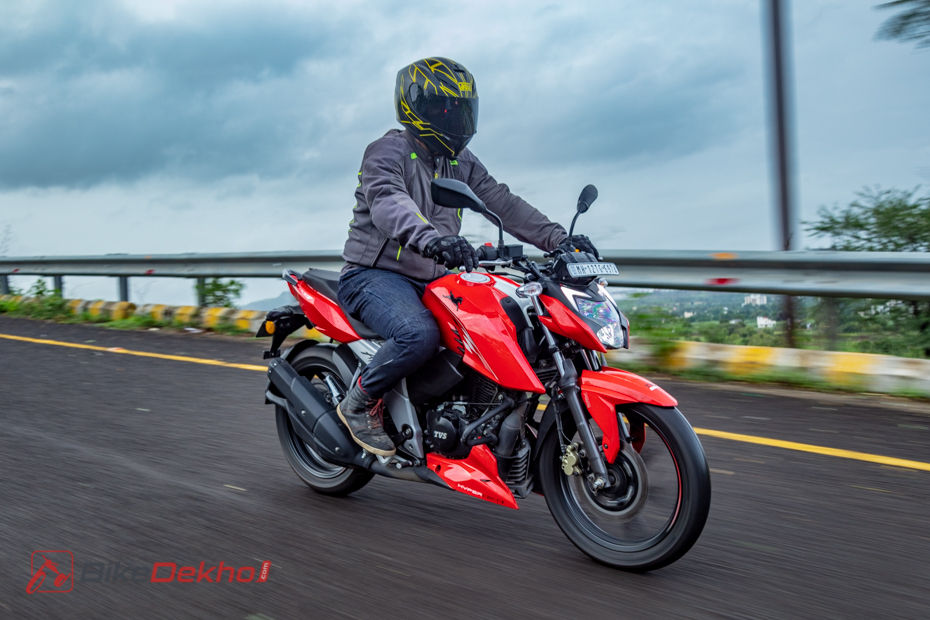2021 TVS Apache RTR 160 4V: Road Test Review
Published On Jun 26, 2021 By Gaurav Sadanand for TVS Apache RTR 160 4V
- 3936 Views
- Write a comment
Is the 2021 performance update on the RTR enough to earn it back the crown in the 160cc segment?

One of the many things that I love about TVS Motors is its commitment to improving itself and its products every year. It’s probably why the RTR range is such a hit among enthusiasts. The styling, attention to detail, performance, and features set it apart from its competition.
However, the Apache RTR 160 4V was the worst hit of all the current TVS bikes during the BS6 transition. Strict emissions norms robbed the bike of its lively performance. It was a whole six seconds slower to 100kmph compared to the BS4 model. We even spoke about it at length in our video. And I guess TVS was paying attention, because it recently rolled out its 2021 RTR 160 4V, which benefits from some performance gains. But how does it fare in the real world?
ENGINE & PERFORMANCE

- The only update on the RTR is its reworked 160cc engine, so we’ll try and keep this short.
- The new revisions to the motor help it extract 1.61PS and 0.61Nm more, with its peak power kicking in 1000 revs later.
- The real bump up in power can be felt post 7000rpm. So the performance gain is mainly concentrated towards the top.
- Not to mention, it’s 2kg lighter than before.

- All of this comes together to make the 2021 RTR four seconds quicker than the previous iteration in its dash to 100kmph.
- TVS has made some headway in the bike’s bottom and mid-range performance as well, but those gains aren’t significant.
- And you still need to work the gearbox to get the most out of the engine.
- Acceleration times have clearly improved but are most noticeable once you climb up the rev range.
- The extra performance does have a ripple effect on the refinement level, but it’s nothing alarming. If anything, the mild vibes kicking in while wringing the throttle makes the bike feel more alive, which brings back memories from the older carb model -- a bike that was revered by almost everyone who rode it.

- So we’ve established that the RTR is quicker than before, but does that affect its fuel efficiency?
- Not exactly. In the city, the RTR is just as frugal as before, however, it does burn a bit more fuel out on the highway. That’s probably because we maintained slightly higher speeds out on the highway since the motor felt more at ease, leading to it being a little less efficient.
RIDE AND HANDLING

- Thankfully, TVS hasn’t meddled with the frame or any of the bike's other hardware. So it continues to be a sharp handler, coming very close to being the best in its class.

- What we would have loved to see, though, is the inclusion of dual-channel ABS, which would have added an extra layer of safety.
- Don’t get me wrong, the current single-channel ABS system works well, but the rear still tends to step out during hard braking, which could get a little unnerving, especially on wet roads.
PRICE AND VERDICT

- TVS has dealt with the RTR’s performance issue and has now made the bike near-perfect, well, except of course those raised eye-brow-like DRLs, which we think are a polarizing aspect of the design. The performance update does come at a slight premium of Rs 1,250, which was announced last month. But we’d say it’s well worth the extra dough.
- The more powerful engine also puts the RTR ahead of its arch-rival, the Bajaj Pulsar NS160, keeping it firmly ahead of its rivals in this segment. Factor in the kind of equipment and features on offer, and the RTR becomes a no-brainer if you’ve got performance on your mind.
